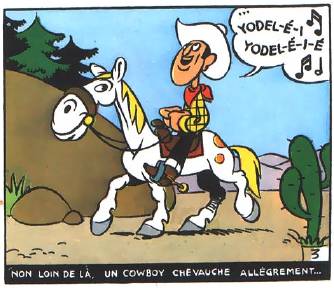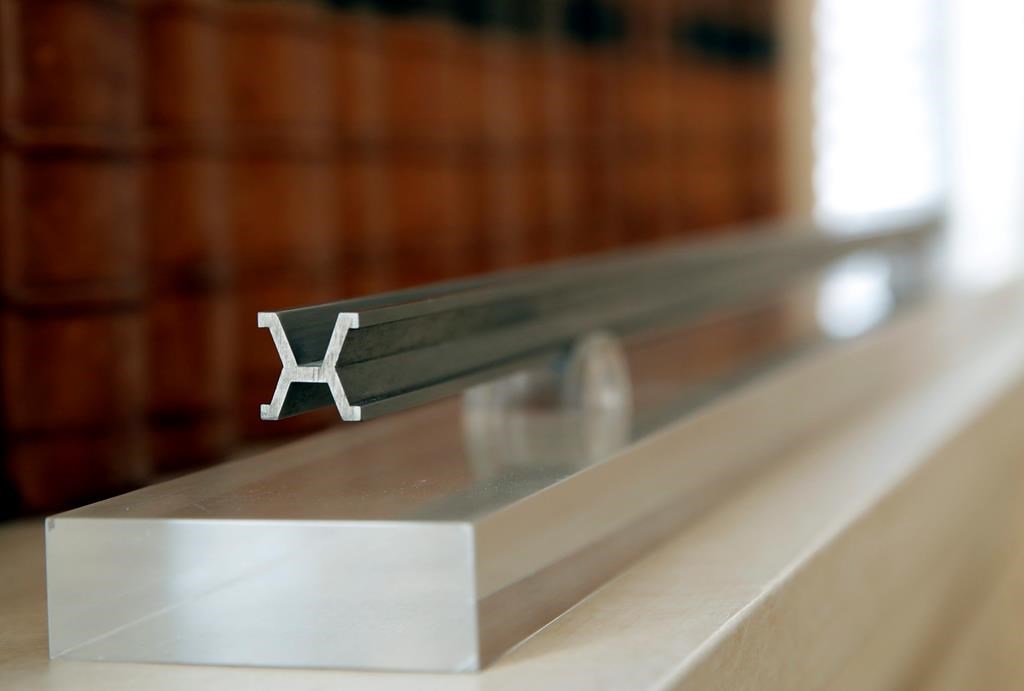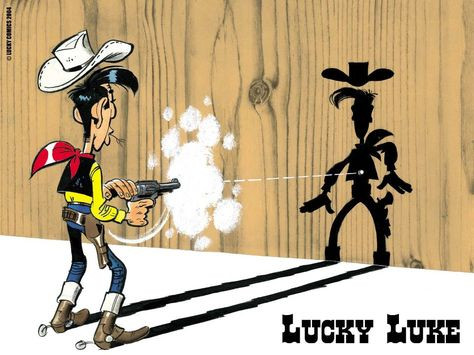As a kid, I would read many French and Belgium cartoons, such as Lucky Luke, the lone cowboy who can shoot faster than his shadow and his horse, Joly Jumper.
Of course, this is a joke for the character has to be really fast to draw and shoot at bad guys so he can win all battles. The whole cartoon has many jokes, with, for example, the Daltons who just can’t do anything right and always end up in jail (well, the real Daltons did not really do much properly either…)
Morris, the Author

Morris, 1946 (first appearance of —)
The author of Lucky Luke was named Maurice de Bevere, most often abbreviated Morris. The first appearance of the character was in the Spirou magazine in 1946.
Morris worked on the cartoon on his own for 9 years. Later he associated with various people, such as Goscinny (known for the Astérix series), to help with the writing. After his death, the cartoon lives on with a new set of artists.
Morris also worked on a cartoon with a dog named Rantanplan. The dog was really stupid but he was still able to help with catching the Daltons. Yes. This was a spinoff of Lucky Luke. All the characters were the same, only Joly Jumper and Lucky Luke were replaced by the dog. Morris never created other cartoons.
Lucky Luke is one of the most sold cartoons of Europe with over 300 million copies sold in 30 different languages.
Lucky Luke and Joly Jumper
Lucky Luke is a lone cowboy who rides a white horse, named Joly Jumper, across the US around 1880.

Along the way, he meets a sorts of bad guys that he has to catch to save the day. People who cheat at poker, people who attack banks and trains, etc.
Lucky Luke can actually talk to Joly Jumper. The horse doesn’t reply, but he follows commands. He can come under a window so Lucky Luke can jump out and save himself from the fire. He can ask him to follow the trail while he sleeps (apparently this horse can sleep walk in the right direction for days and nights). Joly Jumper also has a keen sense of smell, just like a dog.
Joly Jumper also kicks butts of bad guys once in a while, with a big smile on his face.
Got to be Fast!
In order to succeed, Lucky Luke has to be really fast. Faster than the bad guys, for sure. Actually, faster than all the bad guys together! (he can draw and fire four bullets before the Daltons have time to even think of drawing their own weapon…)
According to his resume, often shown on the back of the book, he can draw and shoot faster than his shadow. But how can that be? Nothing can be faster than light, right?
Well… Indeed. However, the shadow is at least 3 meters away from the cowboy so in effect it reacts a little later than the cowboy, right?
Let’s say that the speed of light is exactly 300,000,000[1] meters per second, the math gives us:
So… 1 second, 1 millisecond, 1 microsecond, nope… it’s 1 nano second! It will take about one nano second for the shadow on the wall to get updated. What does that mean? For the shadow to stay in place, the whole movement and shooting has to take 1 nano second or less.
This is true and quite impossible for a human, but…
Let’s consider the time it takes for our brain to see the next image, maybe we have a chance that way? You’ve probably heard of the speed at which computer monitors and TVs refresh the images on the screen. Each full image displayed is called a frame. In the old day, we used a mode called Interlace. We actually only drew every other line on your TV screen and that was enough to trick our brain to think that things were moving naturally.
In the old days, the first movies were created with equipment available at the time and we often were limited to recording only about 12 images per second. Once we played these at a good speed, it made the people in the videos go fast (about 2×).
With time, our technology improved and we were able to increase the speed to 15 fields (two fields represent a frame, a full screen image). Note that in Europe, we used 12.5 fields instead of 15 for a total of 25 frames a second. In the countries that selected NTSC, they used this formula:
In other words, in NTSC we would display one field every 33.4 milliseconds.
We now have much better technology to detect how our eyes can see and we have found out that it takes our eyes and brains about 13 milliseconds to process a new image.
So as we can see, NTSC is a tad bit too slow for the people who have the best eyes, but not by far. Now that we have monitors that can produce 60 frames a second, though, we beat the eye every time (as long as the processors are able to generate the next image in time).
In other words, we are producing one image every 16.7 millisecond. Not too many people can notice the missing frames!
Now, back to Lucky Luke… we just mentioned that the eye could see one image very 13 milliseconds. So we could rearrange the math and say that if Lucky Luke fires in less than 13 milliseconds, then we should see the shadow with Lucky Luke ready to shoot, he shoots and pierce a hole in the wall, and 13 milliseconds later we see the shadow changing to the new position.
So, we can instead calculate how much distance he has to move his arm and whether it’s doable in 13 milliseconds. Let’s assume that the movements required represents about 50 centimeters to take the gun out of the holster and then bring it up straight and shoot:
This is 6.5 mm/s, which I think is perfectly doable. What’s much harder is to do that complex movement perfectly each time. Certainly doable with enough training.
So now what we need is someone with that much training and a very fast camera to prove it. How fast a camera would we need? As we’ve seen, most standard camera register between 30 to 60 images per second. These will not help since they are built for our eyes which capture that kind of speed. So to really prove that the movement can happen before the shadow moves, we need a much faster camera. Commercially available are cameras that can do up to about 20,000 frames per second. This would probably be enough. When you see a video in what we call “slo-mo” (short for slow motion), we actually use this type of camera.
In other words, one image every 50 µs. That will give you enough images to see whether the image just before the 13 ms mark would already show the hole of the bullet or not. If not, you need to get more training and be faster…
Note that in each image, even in the slow motion video, the shadow is going to be moving. However, our brain won’t register all of those images.
Where’s the flow? The fact is that your brain is not likely to see the image just before you start the movement and the image right after. Also the Lucky Luke picture shows a hole in the wall with the shadow still intact from before the firing. That’s definitely incorrect. The camera would show us the hole with the shadow of the person done firing—although a bullet goes fast (faster than the speed of sound), it can’t compete with light. So the bullet hole can’t exist before the shadow has moved.
Yet, our brain would still think of the image before Lucky Luke shoots and by the time the bullet whole appears, our brain would still have that image (assuming a really fast movement). So in that sense, Lucky Luke can be firing faster than his shadow…
Thought this was a fun fact? Or completely idiotic set of equations? Comment below and let me know!
1 The exact speed of light is 299,792,458 meters per second. Note that this the exact speed because we define the meter as:

Although the meter was first defined in 1793 as one ten-millionth of the Earth circumference between the equator and the North Pole. Previous attempts, like in 1671 using a pendulum failed as the size would vary depending on your location on Earth. It’s only in 1799 that we created the first one meter bar (it was replaced once in 1889). To make it more accessible, one meter was converted to a certain number of wavelength of Krypton-86. However, in 1983 it was internationally decided to use the speed of light like above so as to have less argument about how long 1 meter really is. The last modification (at time of writing) happened in 2019.

Leave a Reply